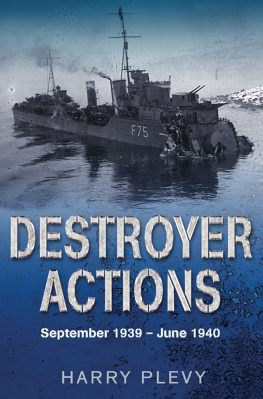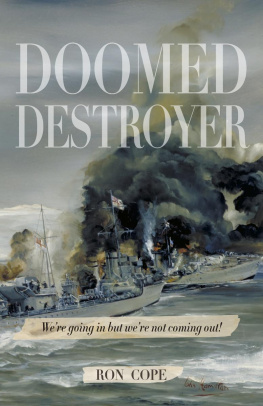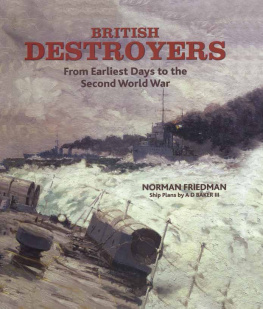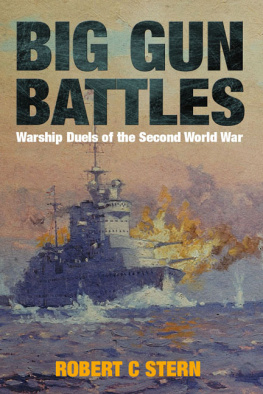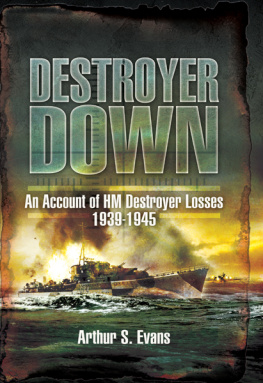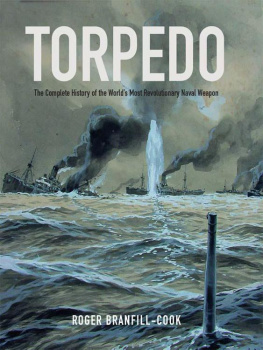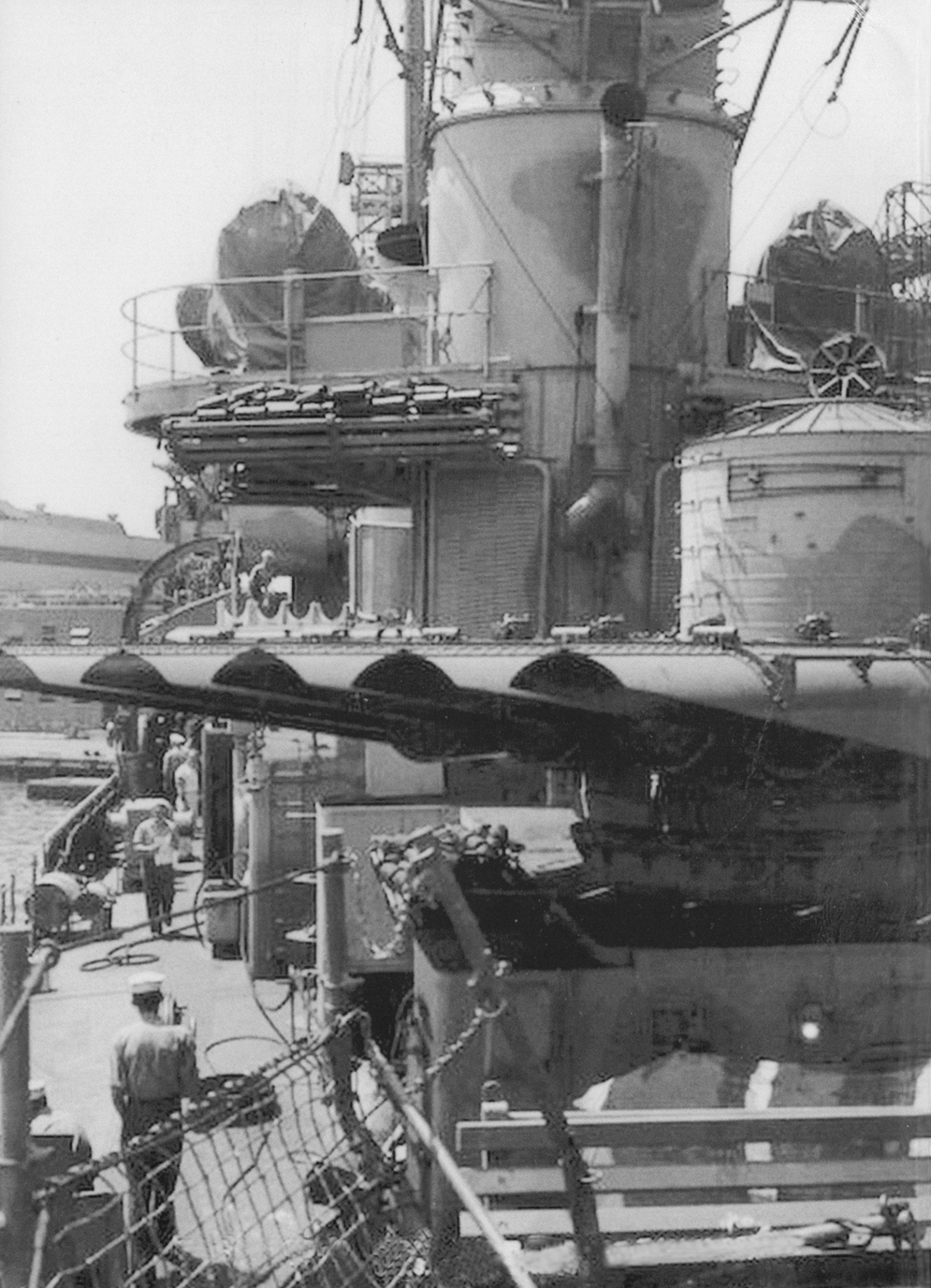DESTROYER BATTLES
DESTROYER
BATTLES
EPICS OF
NAVAL CLOSE COMBAT
ROBERT C STERN
Dedication
To Beth, my lovely, long-suffering wife far better than I deserve.
FRONTISPIECE:The raison dtre of the destroyer the torpedo, represented here by the after
bank of quintuple tubes on uss Fletcher (DD 445) in this shipyard view, taken at New York
Navy Yard, 15 July 1942, just before she headed to the Pacific and her participation in the Battle
of Tassafaronga. The cylindrical housing on these torpedo tubes protected the two-man crew
(trainer and gyro setter) from the blast of the 5in (127mm) mount just aft. (The forward bank
of torpedo tubes did not have this blast shield.) The wavy patches of Ocean Grey (5-O) over a
base of Haze Grey (5-H) are part of the Ms 12 Mod camouflage scheme she carried at the
time. (NARA via destroyerhistory.org)
Copyright Robert C Stern 2008
First published in Great Britain in 2008 by
Seaforth Publishing
An imprint of Pen & Sword Books Ltd
47 Church Street, Barnsley
S Yorkshire S70 2AS
www.seaforthpublishing.com
Email info@seaforthpublishing.com
British Library Cataloguing in Publication Data
A CIP data record for this book is available from the British Library
ISBN 978-1-84832-007-9
All rights reserved. No part of this publication may be reproduced
or transmitted in any form or by any means, electronic or mechanical,
including photocopying, recording, or any information storage
and retrieval system, without prior permission in writing
of both the copyright owner and the above publisher.
The right of Robert C Stern to be identified as the author
of this work has been asserted by him in accordance with the
Copyright, Designs and Patents Act 1988.
Designed and Typeset by MATS Typesetters, Leigh-on-Sea
Printed and bound in Great Britain by Biddies Ltd, Kings Lynn
Contents
A s is always the case, this book could not have been written without the aid and co-operation of many people, going back over the more than 30 years during which I have been collecting the materials both photographic and documentary used here. Im afraid I failed to record the names of many who helped me early in this process, as then my collecting was out of personal interest, with little thought that books might result in the future. To any whose names I dont recall, I offer my apologies.Those I do remember are listed below.
To Janis Jorgensen and the staff at the US Naval Institute, I am most grateful for supplying multiple oral histories, invaluable in writing chapter 8; to Tosun Sarai of Ankara, Turkey, I am truly indebted for supplying the translation from Turkish of the account of Lieutenant Ali Haydar, and for several valuable photographs; to Peter J Green, I am indebted for his excellent personal account of the Falklands War and especially for his permission to use several of the photographs on his website; to Dan Withers for his excellent web site covering the Nasty boats of the Vietnam War and for his assistance with photographs; to Dave McComb for his in-depth research into US Navy destroyers and his generous help with chapters 7, 8 and 9. Also for introducing me to Rick E Davis, who helped describe the gun fit of US destroyers in the Solomons; to Captain Russell S Crenshaw, Jr, USN (Ret) for permission to quote from his writings.
To any others I may have neglected to list here, thanks again.
As always, if despite this great help, errors have crept into this narrative, they are solely my responsibility.
Notes on Units of Measurement
(and a Few Other Things)
I t is difficult, when looking through historical documents and reference works from any period, to find a consistent set of units by which ships and everything related to them were measured. Further, being an American author writing in 2007, it is impossible to ignore the fact that every other developed country besides the United States has adopted the metric system, at least officially.
Given all this, I have been forced to make decisions about which units to use in this book and have tried my best to stay consistent with these decisions. There are two places where my best efforts have been most challenged. One is in the area of gun calibres. I have decided in this case to simply use the designation system(s) of the nation whose weapon is being described and have added an appendix to explain as best I can how the various systems correspond to each other.The other case is when Im quoting a source that used a measurement system other than the one I adopted for this book. In those cases, I have retained the original measurement system used by the sources author. In all other cases, I have attempted to use the following units consistently:
Distance/length In general, distances are given in nautical miles. A nautical mile is 2025 yards; in metric terms, it is 1852 metres. It is equivalent to 1.1508 statute miles. For many uses, the US Navy historically simplified the nautical mile to 2000 yards. The British have sometimes used a definition of 6080ft, also known as an admiralty mile. However, since 1929, an international standard has been generally accepted, based on a nautical mile being exactly 1852 metres. The US Navy adopted this standard only in 1954.Whenever I use the word mile, even when not preceded by the word nautical, I mean a nautical mile. Shorter lengths, typically those less than one mile, I give in metres. The only exception to these rules is when I am giving a distance that is purely a measure of travel on land, such as the distance from Paris to Berlin. In these cases, I use kilometres.
Time I use the nautical twenty-four-hour clock throughout. Keeping track of time zones is next to impossible, as it was almost always true that when one destroyer sighted another, their clocks would not have agreed, any more than their politics. In general, I have used the time zone of the first ship mentioned in the narrative and adjusted the other ships to agree.
Displacement In this matter, I have made no attempt to reconcile long tons, short tons and metric tonnes, since knowing the exact displacement of a ship never alters the outcome of the stories. In most cases, the sources do not specify which ton theyre using. (Displacement is normally, but not always, given in long or English tons.) I give standard displacement when it is distinguished from other displacements (eg, normal or full load). I make no attempt to reconcile the various interpretations of what standard displacement means in different navies. In general, I try to find a consensus between sources before giving a displacement. Merchant ship displacements are given as GRT (Gross Registered Tons), which is actually a unit of volume (1 GRT is 100 cubic feet or 2.83 cubic metres).
Speed Always given in knots (nautical miles per hour).
Weight I use kilograms and tonnes whenever possible.
Place names are also a problem, in that much of this history took place at a time when many of the locations of the action in these stories were under colonial administration. Colonial powers tended either to give new names to the places they administered, or give the local names new pronunciations and spellings that fitted the ears and tongues of the administrators. As a result, many of the place names used by the combatants in these wars would not be found on a map today. I have opted to use the names and spellings of the period and power in question and to give the contemporary name when useful in footnotes.
Next page










